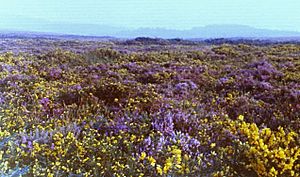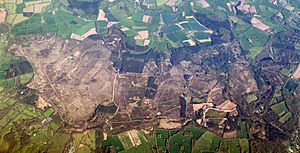Woodbury Common, Devon facts for kids
Woodbury Common is a large area of open land in East Devon, England. It's mostly covered in heathland, which is a type of habitat with open, low-growing plants. The common is next to the village of Woodbury. It's also close to the towns of Exmouth and Budleigh Salterton.
This special area is part of the East Devon Area of Outstanding Natural Beauty. It is also a Site of Special Scientific Interest, which means it's protected because of its important wildlife and geology.
Inside Woodbury Common, you'll find Woodbury Castle. This is an ancient Iron Age hill fort. From here, you can see amazing views. You can look west towards the villages of Woodbury and Woodbury Salterton. You can also see across the Exe estuary to the Haldon Hills. Looking east, you can see the Otter Valley.
The heathland is full of gorse and different types of heather. It's a popular place for outdoor activities. People enjoy orienteering, which is like a treasure hunt with a map and compass. Many also come for hill-walking, mountain biking, and flying radio-controlled aircraft.
Woodbury Common is home to many animals. One special bird is the Nightjar. This bird flies all the way from Africa each year to spend the summer here.
A part of the common is used as a training ground for the Royal Marines. They are based nearby at Lympstone. Also, at the north end of Woodbury Common, there's a hotel, golf, and country club. It was started by the famous former Formula One race car driver, Nigel Mansell.
Contents
A Look Back: The Battle of Woodbury Common
The Battle of Woodbury Common happened on August 4, 1549. It was a part of a bigger event called the Prayer Book Rebellion. This rebellion involved people from Cornwall and Devon who were unhappy with changes to the church.
The King's Army Arrives
The king's army was led by John Russell, 1st Earl of Bedford. He was tasked with stopping the rebels. On August 2, 1549, more soldiers arrived to help Russell. These included soldiers from Italy and Germany, led by Lord William Grey.
Marching Towards Exeter
The next day, the king's army, with about 5,000 men, started marching. Their goal was to reach Exeter, which was under attack by the rebels. Instead of taking the main road, which was blocked, Russell's army went across the open land.
Clash at Alfington
Russell's scouts found about 2,000 rebels blocking their way at Alfington. Captain Travers was sent to clear the path. The rebels who were disarmed during this fight faced a harsh end.
Camping at Woodbury Common
Russell's army continued their march and set up camp at a windmill on Woodbury Common. The Italian commander, Paulo Batista Spinola, kept his soldiers awake all night. He was worried about a surprise attack from the rebels.
The Battle Begins
His fears came true at dawn on August 4. Forces from Devon and Cornwall came out from Clyst St Mary to fight the larger army at the windmill. Even though the king's army had more soldiers and better weapons, the rebels were not afraid.
Aftermath of the Battle
The battle was fierce, and both sides lost many soldiers. The fight didn't have a clear winner on the day. However, Russell's army captured many rebels. Sadly, the next day, 900 of these prisoners were executed in what is known as the Clyst Heath massacre. This sad event was recorded by a historian named John Hayward.



